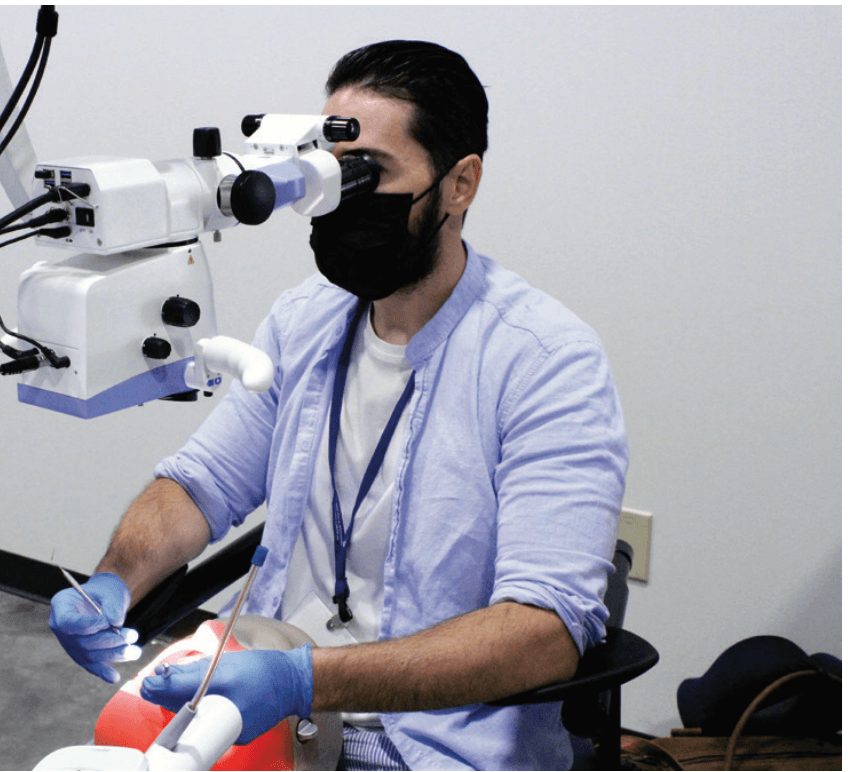Dr. Juan Carlos Ortiz Hugues explains how magnification and attention to ergonomics can help both the dentist and the patient.

Dr. Juan Carlos Ortiz Hugues explains how dental microscopes can improve precision and clinical accuracy
The introduction of the dental microscope into clinical dentistry in the 1990s marked a significant milestone in the field, with its adoption in endodontic programs accredited by the Commission on Dental Accreditation (CODA) in 1998.1 This technology has fundamentally transformed dental practice by offering superior magnification and lighting, which have enhanced the precision of procedures and improved clinical outcomes.
One of the key advantages of the dental microscope is its ability to provide high levels of magnification, allowing clinicians to detect minute details that are often invisible to the naked eye. This is especially important in complex procedures like root canal therapy, where precision is crucial for successful outcomes. The microscope’s superior illumination also ensures that the working area is brightly lit, reducing the risk of errors caused by poor visibility and facilitating better diagnosis and treatment.
Magnification: transforming visual precision
Dental microscopes offer various magnification levels, typically in increments of 5 to 6, ranging from low to high magnification. At the highest setting (20x), these microscopes provide up to 400 times more visual information than the naked eye and 100 times more than 2x magnifying glasses.2 As magnification increases, the resolution and clarity of the visual field improve, enabling dental professionals to achieve exceptional precision in clinical procedures.

Illumination: eliminating shadows for optimal visualization
A key feature of dental microscopes is their coaxial illumination system, which is integrated into the optical structure. This system ensures 100% shadow-free lighting along the operator’s visual axis, providing a uniformly illuminated field of vision. This advanced lighting surpasses the limitations of traditional magnifying glasses, enhancing diagnostic and procedural accuracy significantly.
Addressing precision and ergonomics in dentistry
Incorporating ergonomic principles into the use of the dental microscope has further amplified its benefits. With the addition of adjustable positions, optimal posture can be maintained during lengthy procedures, thereby reducing operator fatigue and musculoskeletal strain. This focus on ergonomics not only promotes the longevity and health of the practitioner but also enhances comfort and efficiency during treatment.3
Real-time documentation: building trust and transparency
The ability to document procedures through the microscope’s built-in camera enables practitioners to capture high-quality images and videos for educational purposes, patient records, and legal documentation. This fosters a more comprehensive understanding of the treatment process and allows for better communication with patients.
The integration of the dental microscope, coupled with ergonomic principles, has significantly elevated both the quality of care provided and the well-being of dental professionals. The continued adoption of this technology, along with the emphasis on ergonomic best practices, promises to further refine clinical outcomes and optimize the working environment for dental practitioners.
Dr. Andrew Steidley gives an overview of the history of magnification in his CE, “The dental operating microscope through the years: past, present, and future.” Read it here, and subscribers can take the quiz and receive 2 CE credits! https://endopracticeus.com/ce-articles/the-dental-operating-microscope-through-the-years-past-present-and-future/
- American Association of Endodontists (AAE). Position Statement – Use of Microscopes and Other Magnification Devices. 2020. www.aae.org. Accessed January 6, 2025.
- van As GA. Magnification alternatives: seeing is believing, Part I. Dent Today. 2013 Jun;32(6):82-87. PMID: 23802377.
- Juan Carlos Ortiz Hugues. Applied Ergonomics and Microscope Dentistry, A Need for Quality Dentistry, and Prolonged Performance. Systematic Approach Concept: Applied Ergonomics and Microscope Dentistry. Inter Ped Dent Open Acc J. 2023;8(4):706-708. Published August 10, 2023. doi: 10.32474/IPDOAJ.2023.08.000295. Accessed January 6, 2025.
Stay Relevant With Endodontic Practice US
Join our email list for CE courses and webinars, articles and more..

 Juan Carlos Ortiz Hugues, DDS, CEAS II, AEP, is a master of the Academy of Microscope Enhanced Dentistry (AMED), and current president of the AMED. He is an endodontist in private practice in Panama. Dr. Ortiz Hugues lectures and provides hands-on training throughout the world on endodontics, microscope dentistry, and advanced ergonomics. He wrote the book, Ergonomics Applied to Dental Practice.
Juan Carlos Ortiz Hugues, DDS, CEAS II, AEP, is a master of the Academy of Microscope Enhanced Dentistry (AMED), and current president of the AMED. He is an endodontist in private practice in Panama. Dr. Ortiz Hugues lectures and provides hands-on training throughout the world on endodontics, microscope dentistry, and advanced ergonomics. He wrote the book, Ergonomics Applied to Dental Practice.